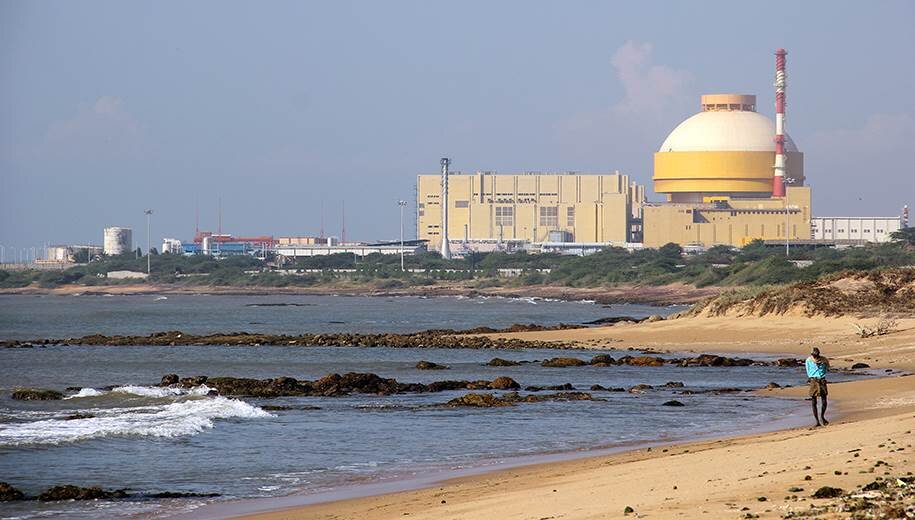The nuclear power plants located along the coastline of India and Pakistan face the risk of tsunami.
According to a new study, a major tsunami in the northern Arabian Sea could severely impact the coastlines of India and Pakistan. The coastlines of these two neighbouring countries are dotted with sensitive installations including several nuclear plants. It is assumed that if a tsunami were to strike the northern Arabian Sea, it could seriously redefine the coastlines of India and Pakistan.
The nuclear power plants in both countries are located along the coasts because these nuclear plants have enormous cooling needs that can be taken care of easily and cheaply by using the seawater. Atomic power stations functioning along the Arabian Sea include Tarapur in Maharashtra state, Kaiga in Karnataka, and Karachi in Pakistan.
Research published this month in the journal called Pure and Applied Geophysics, reveals that seismic activity in the Arabian Sea would cause far more damage than expected. C.P. Rajendran, lead author of the study says, “A magnitude 9 earthquake is a possibility in the Makran subduction zone and consequent high tsunami waves are being noticed.”
“Our study is a step towards understanding the tsunami hazards of the northern Arabian Sea,” says Rajendran. “The entire northern Arabian Sea region, with its critical facilities, including nuclear power stations, needs to take this danger into consideration in hazard perceptions.”
An earlier study published in 2013 in Geophysical Research Letters, has suggested that tsunamis, similar in magnitude to the one caused by the 2004 Sumatra earthquake, could occur at the Makran subduction zone where the Arabian plate is subducting beneath the Eurasian plate by about 1.5 inches per year.
It is often believed that nuclear plants are subject to severe accidents due to purely internal causes. But natural disasters like earthquakes, tsunamis, and hurricanes are the reason that ideally stresses on the reactor failures while simultaneously disabling one or more safety systems. Therefore, building nuclear reactors in areas prone to natural disasters is not very wise.
Nuclear plants wrecked by tsunami- Fukushima Daiichi Accident:
In March 2011, the world watched in awe at the sheer destructive power of the tsunami that struck Japan. The tsunami was followed by an earthquake off the east coast of Japan, it was the largest quake ever to hit Japan. However, in wake of the tsunami, another disaster emerged- the Fukushima Daiichi nuclear disaster, which by some is referred to as the largest nuclear disaster after the Chernobyl disaster of 1986.
The nuclear plant in Fukushima suffered major damage from the magnitude 9.0 earthquake and tsunami that hit Japan in 2011. According to reports, the chain of events led to the radiation leakage in the nuclear plant. The disaster disabled the reactor cooling systems and paved the way for the radioactive radiations to trigger the zones surrounding the plant. The uncontrolled releases of radiation emitted from the nuclear plant continue today as well.
Countries with nuclear power plants most at the risk of tsunamis:
The tsunami that destroyed a nuclear reactor at Fukushima caused a major re-think all over the world. Scientists have highlighted this disaster as a wake-up call, and are continuously studying the potentially dangerous areas that are home to nuclear power plants. This is done in order to make appropriate plans to fight shy of the disasters that not only damages the present but also the future.
China currently has 21 operating nuclear plants, and 27 being built. The Chinese government plans to triple the country’s nuclear power capacity by 2020. This is mostly to move away from coal-powered plants for environmental reasons. China’s most active earthquake zones are in the interior, far from its existing nuclear plants on the east coast. However, high earthquake activity on the Chinese east coast should not discount this threat. Moreover, as its electricity needs to grow, China is likely to site new nuclear plants in the interior.
Like Japan, Taiwan is considered to be at high-risk of nuclear reactor damage from tsunamis due to its high frequency of earthquakes. Similarly, South Korea, United States, India, Pakistan, and Iran are among the countries whose nuclear power plants are located in tsunami risk zones. It is therefore important to take steps through which we can avoid disasters of the future.

